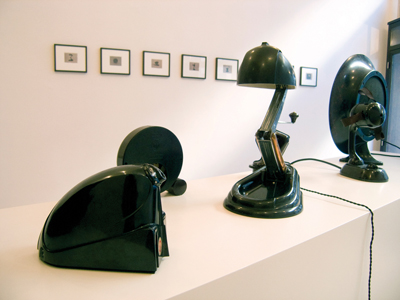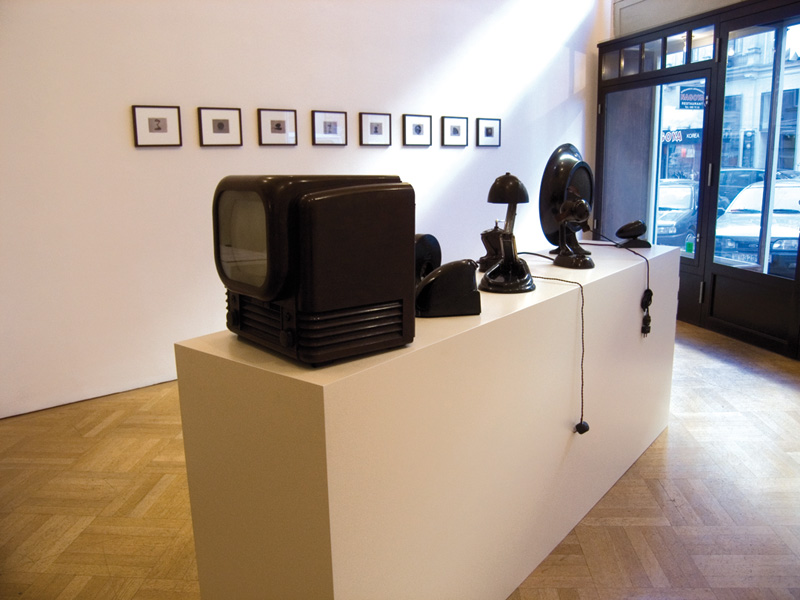
The Stuff Histories Are Made Of
Upon entering the room, we find ourselves immediately among a series of objects and a series of pictures. Eight objects are placed opposite eight photographs on the wall, and the visitor stands between them. We find ourselves at the interface between the two. The dramaturgical aspect of the mise en scène is striking, but we don't know in what play we're acting. So we take a look around.
The objects, which all seem to be made of the same material, obviously come from a century that we have already left behind us and which we hardly know anymore. It is a collection of small everyday plastic objects: Inventing the 20th Century (Bakelite).

The black-and-white photographs, framed with dark-brown wooden frames and white matting, are each 10 x 8 centimeters—a rather unusual format. They show the same objects as those placed on the pedestal opposite them, before a gray backdrop. The photographs seem so antique that we aren't really sure what's older: the objects or the photographs: Inventing the 20th Century (Bakelite).
01rdx.jpg) |
02rdx.jpg) |
But the historical and cultural continuation of a technological development in the twentieth century apparently central to this installation is initially kept from us. We thus quickly find ourselves in a certain inscrutability that contradicts our first impression of the work. Instead of receiving a historical explanation, we find ourselves standing before an unexpected "mise en abyme," in which each object is literally placed before an abyss.
This abyss seems to be nothing less than the abyss of the history of the twentieth century itself. The impossibility of being able to grasp this span of time, something of which we have long been aware, does maintain the possibility of searching for escape routes to the past, which in turn invent our present. With two such historical brackets, the installation keeps us on the edge of the conceivable and begins to tell a story:
The first bracket reads Bakelite. Eight objects: containers, forms, casts. Plastic. One material, thousands of uses. The formal link introduces us in a sentence to this historic material, which celebrates its 100th birthday this year. Bakelite, the first synthetic mass plastic, was a historic and commercial success, and on the eve of World War II, when the patent expired, Bakelite had come to equip most living rooms of the Western world with everyday Bakelite objects, decisively shaping modern design. Although at first hindered by the weakness that it could not be stained, making it instantly recognizable with its dark brown to black color, it ultimately came to inspire the imaginary of the age, and fed all sorts of utopias of a world shaped entirely according to our imagination. When Stansilav Lem described a Bakelite planet in 1951, he could hardly have imagined that the material would still be in use today in space travel.
While the eight objects stand before us, seemingly delicate and tame, plastic continues its triumphant march through the everyday life of our twenty-first century, hand in hand with the flood of concrete and images. The objects thus stand as testimony to something that they first materialized, and that we will long have around us. At the same time, they hang there, exposed in these photographs as if fresh from the factory, arranged for a commercial. The material quality and formal rigor of this series of photographs forces us not only to perceive the depictions, but also to consider their entire context. This recalls a formal, media-critical attitude that brings us to the second bracket of the story. Here too, the information leads us into an unexpected field in which we find ourselves suddenly in a parallel (hi)story about Bakelite.
The images are captured on Velox photo paper. Velox was invented in 1893, and was the first photographic paper that could be exposed using an artificial light source, for the first time enabling darkroom photography for the masses. For over seven decades, it was commercially distributed by Kodak and in this period captured countless memories, experiences, fantasies, and personal visual worlds before it was supplanted bit by bit by other papers.
Before the abyss of the history of a century, this installation thus establishes a fixed web between two materials that determined this history. Just as Bakelite exemplarily stood for the beginning of the plastic age, and thus for the mass production of objects and the rise of commodity fetishism, , the photographs are not just a sign for the material onto which they were developed, i.e., Velox itself, but refer to photography's entanglement in the reproducibility of things and how these things become a projection surface for all our desires.
The historical proximity of these two inventions would normally mark a distanced and objective field if it were not for single biography to which both can be traced back, bringing us to a point of historical uncanniness. For it was the chemist Leo Baekeland, a Belgian immigrant to the United States and researcher with a sense for the pulse of the time, who invented these two materials, both of which shaped a world. What today particularly characterizes his genius is his intimate understanding for what industry of his age desired: consumer goods that the masses could afford and materials appropriate for mass production—commodities for the booming world market. When he sold the patent for Velox in 1899 to Eastman Kodak for the then inconceivable sum of 1 million dollars, this showed the new importance of capital just before the start of the new century, along with the capitalist expectations placed in this new age. Without hesitation, following the newly established logic, Baekeland invested the capital in new research. Eight years later, he invented the first entirely synthetic plastic, Bakelite. And one hundred years later, both materials have achieved cult status.
We are thus placed in the midst of the lifework of a single figure who portrayed an entire age in two materials. This focusing of importance in a single biography quickly exceeds our own power of imagination, and serves as a mnemotechnique between present and past. Inventing the 20th Century (Bakelite) expands in a double perspective that can be seen from both ends. What is being invented here?
First of all, if not obviously, a context seems to have been invented, that the artist creates for himself and his work. The strategy consists in first studying the institution in which the work is being shown. During his research on the gallery, its space, and its history, he encountered stories and of course the gallery owner himself. He found out for example about the private Bakelite collection that Georg Kargl began at age 15, which now consists of over 400 objects. Christian Mayer thus used the exhibition as an occasion for a research that lead him to a starting point for his own interest. The Bakelite collection provided the artist with an affect that he could pursue. This affect led to an exchange between his own passion for history and everyday objects of use, and this material that offered him a broad contextual field in which to operate. The dynamism of the exchange gains however in precision with Mayer’s decision to separate from the subjective charge of the collection, without repressing it, and to then focus exclusively on the objective criterion behind it: the material itself, the Bakelite, and the stories linked to it.
The eight pairs consisting of object and photograph, as they are staged in the installation, emerged along a process of research that integrated institutional critique, conceptual and installative processes in art history, historical research, and media critique. But these couplings dissolve before this background and become time capsules that are constantly switching status between image and object. An oscillating movement emerges between thing and sign that can never be captured in a single meaning. But what remains explicitly current before us is the material itself. The artwork before us consists in showing us the stuff not only of which our dreams are made, but our entire world.
Yves Mettler
